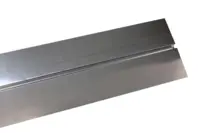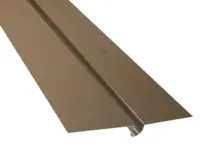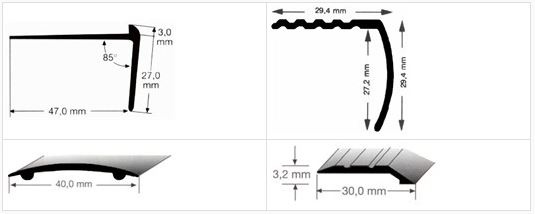- Forside
- Gode råd om gulv
- Konstruktioner
- Tilbehør og specialmaterialer
- Akustikpaneler
- Afpassede tæpper
- Bambusgulve
- Bordplader & bordben
- Designgulve
- Fliser og klinker
- BeefEater gasgrill
- Gode råd om gulv
- Gulvtæpper
- Gulvvarme
- Græstæpper
- Korkgulve
- Køkken, bad & garderobe
- Laminatgulve
- Linoleumsgulve
- Maling, Væv & Spartel
- Måtter
- Møbler & Boliginteriør
- Nålefilt og messetæpper
- Plejeprodukter
- Restpartier & gode tilbud
- Sildebensparket & Stavparket
- Tæppefliser
- Terrassebrædder
- Tilbehør
- Trægulve
- Vareprøver
- Vinylgulv
- Værktøj
- Øvrige produkter
- Loft- og vægpaneler
- Flotte gulve
- Fyrretræsgulv
- Klikgulve
- Bestilte varer
-
-26%
-
Populær29,00 DKK
-
29,00 DKK pr m2
-
Populær21,00 DKK
-
29,00 DKK pr m2
Tilbehør og specialmaterialer
Alle informationer på denne side er kopieret materiale fra Gulvfakta som er et fagteknisk opslagsmateriale, Kilde: Gulvfakta
Ved udførelse af gulve er der behov for at anvende et antal forskellige tilbehørsdele, bl.a. for at kunne udføre detaljer ved samlinger og afslutninger.
2.3.0.1 Introduktion
2.3.0.2 Profiler og lister
2.3.0.3 Brandskinner
2.3.0.4 Måtter
2.3.0.5 Afdækningsmaterialer
2.3.0.6 Fuger
Alle informationer på denne side er kopieret materiale fra Gulvfakta som er et fagteknisk opslagsmateriale, Kilde: Gulvfakta
2.3.0.1 Introduktion
Tilbehørsdelene kan naturligt deles op i grupperne:
• Profiler og lister
• Tråd
• Måtter
• Afdækningsmaterialer
• Fuger
Grupperne gennemgås i det efterfølgende kortfattet, idet der for hver gruppe dels er forskellige materialer til rådighed, dels findes et stort udvalg af forskellige typer.
Det efterfølgende skal altså blot betragtes som typiske eksempler på, hvad der findes/benyttes, mens mere specifikke oplysninger om opbygning, brug etc. må indhentes hos leverandørerne.
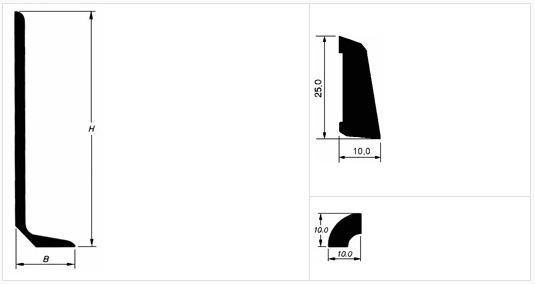
2.3.0.2 Profiler og lister
Profiler og lister til brug i forbindelse med gulvlægning fremstilles normalt enten af træ, PVC, metal eller gummi.
Lister
Lister, der anvendes ved gulvarbejde, findes i træ eller plast, fx i form af:
• Fodpaneler
• Sandlister
• Kvartstaflister
Metalprofiler
Metalprofiler findes i aluminium, rustfast stål eller messing. Der findes profiler til flere anvendelsesområder, fx:
• Trappeforkanter
• Overgangsskinner
• Afslutningsskinner
• Brandskinner
Metalprofiler leveres i mange typer og til flere belægningstykkelser. Profilerne leveres i længder op til ca. 5 m. Profilerne kan fastgøres ved limning eller skruning.
Metalprofiler med skridsikkert indlæg
Trappeforkanter med skridsikkert indlæg er velegnede, hvor der er meget færdsel, og er på grund af indlægget normalt skridsikre både i våd og tør tilstand. Skal der benyttes profiler med skridsikkert indlæg på steder, hvor der anvendes olie, vegetabilsk fedt, eller hvor der er meget fugt, bør det sikres, at der anvendes produkter i resistente materialer.
Profilerne leveres i længder op til ca. 5 m.
Profilerne kan fastgøres ved limning eller skruning.
Profiler af PVC
Profiler af PVC findes til mange forskellige formål og i mange farver. Afhængigt af profiltype leveres PVC-profiler i afpassede længder op til ca. 5 m eller i oprullet stand i længder op til ca. 30 m.
PVC-profiler monteres normalt ved kontaktlimning. For fodpaneler og trappeforkanter af PVC gælder normalt, at kun én flade fastlimes til underlaget. Den lodrette flade på et fodpanel og den vandrette flade på en trappeforkant.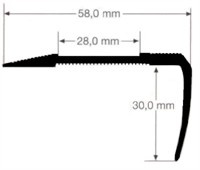
2.3.0.3 Brandskinner
Skinneløsninger til branddøre.
Brandbare gulvbelægninger må ikke føres ubrudt gennem branddøre. Gulvbelægninger skal adskilles af en skinne i stål eller messing med samme bredde som dørbladet.
Såfremt branddøren er uden anslag ved dørunderkant, placeres skinnen direkte under dørbladet med max. 6 mm luft.
Skinner findes i standardhøjderne 3, 4 og 5 mm.
Skinnens højde afhænger af undergulvet:
• Er undergulvet udført af et brandbart materiale (fx spånplader, krydsfiner e. lign.), skal der anvendes en 5 mm høj skinne
• Er undergulvet udført i et ikke brandbart materiale (fx beton), kan skinnens højde reduceres så den passer til gulvbelægningen
Af hensyn til beskyttelse af gulvbelægningens kanter, er det hensigtsmæssigt, at skinnens højde mindst er lige så høj som gulvbelægningen ved ikke brandbare undergulve.
Eksempelvis bør der vælges en 3 mm skinne til 2,5 mm Linoleum og en 4 mm skinne til 3,5 mm Linoleum etc.
Skinner bør altid vælges ud fra gulvbelægningens type, konstruktion og højde under hensynstagen til gældende brandkrav.
Ved montering af skinner både før og efter gulvbelægningen, vil der som regel være gode højde- og tilpasningsmuligheder i hhv. skinne og/eller gulvbelægning.
Der må alligevel altid skulle accepteres en højdeforskel på op til 1 mm mellem gulvbelægningen og skinnen.
Ved tekstile gulvbelægninger må der forventes større højdeforskelle mellem gulvbelægningen og skinnen, end ved andre typer gulvbelægninger, da tekstile gulvbelægninger er fleksible grundet forskellige vævemetoder og konstruktioner.
2.3.0.4 Måtter
I forbindelse med gulvlægningsarbejde vil der ofte være behov for at udføre dele af gulvet omkring indgangspartier i form af måtter. Måtter findes i flere forskellige udgaver og materialer, fx gummi, metal og textiler.
Den bedste effekt opnås, hvis der benyttes en kombination af måtter, så der opnås både en skrabe- og sugeffekt.
Måttearrangementer bør være så store, at der i det mindste gås 4-6 skridt på dem. Dette vil skåne de egentlige gulvbelægninger for den værste tilsmudsning, hvorved deres levetid forøges. Samtidig vil det nedsætte rengøringsudgifterne.
2.3.0.5 Afdækningsmaterialer
I byggeperioden bør nylagte gulve beskyttes mod tilsmudsning fra færdsel og efterfølgende håndværkere.
Hvordan afdækning af gulvene skal ske, afhænger af den type belastning, gulvene udsættes for mellem lægning og ibrugtagning, fx brugsintensiteten og om der kan forventes tør eller våd belastning.
Hvis gulvene først udlægges meget sent i byggeprocessen, kan beskyttelsen evt. indskrænkes til en gangstribe eller helt udelades.
Det skal fremgå af beskrivelsen:
• Hvilken type afdækning, der skal benyttes.
• Hvem der skal sørge for afdækning.
• Hvem der skal vedligeholde afdækningen.
• Hvem der skal rengøre den, inden den fjernes.
• Hvem der skal fjerne den.
For at undgå buledannelse bør afdækning af halvhårde gulve først foretages, når limen er hærdet.
Afdækning kan ske i henhold til efterfølgende retningslinier:
I ganglinier vil færdslen normalt være hård, og anden afdækning bør da suppleres med hårde træfiberplader.
2.3.0.6 Fuger
Fuger i gulve kan udføres enten for at optage ekspansioner og/eller videreføre kræfter, eller blot for at lave en markant inddeling af gulvfladen (skibsfuger/nåddefuger).
Udformningen af fugerne afhænger dels af hvor store bevægelser, der forventes, og dels af den eller de typer af gulvbelægning, der indgår.
Fugeprofiler udføres oftest som skinner eller profiler i metal. Egentlige fugeprofiler anvendes hovedsagelig, hvor der forventes større bevægelser i gulvfladen.
Til mindre fuger i trægulve kan der anvendes fugemasser eller fugeprofiler i gummi eller plast. Til fuger i skibsgulve kan anvendes fugemasse, trælister eller gummilister i en kontrastfarve.
Fuger skal udformes, så de kan optage de bevægelser, der forventes i de aktuelle gulvflader. Antal og placering af fuger er bestemt af gulvets konstruktive opbygning, belastningen, de forventede fugtvariationer, rummets geometri og gulvkonstruktionens opbygning.
For svømmende gulve vil store mekaniske belastninger, fx tunge reoler eller skranker i kontorlandskaber, hindre gulvets bevægelsesmuligheder. Det begrænser størrelsen af de gulvflader, der kan udføres uden fuger.
Også anvendelsen af forholdsvis hårde og stærke fuger mod tilstødende gulve eller bygningsdele vil kunne hindre gulvfladens frie bevægelse.
Hvor der forventes store fugtvariationer, stilles der de største krav til gulvets udvidelsesmuligheder, og dermed til antallet og størrelsen af fuger.
Ved gulve med uregelmæssig geometri, og hvor der er søjler gennem gulvfladen, skal det påses, at gulvets bevægelsesmuligheder ikke hindres.
Opdeles gulvfladen, bør det så vidt muligt ske i rektangulære felter, så de forventede bevægelser i begge retninger er nogenlunde ens.
Der skelnes mellem dilatationsfuger, isolationsfuger og nåddefuger.
Dilatationsfuger
Dilatationsfuger benyttes til at optage fugt- og temperaturbetingede bevægelser mellem materialer i gulvfladen.
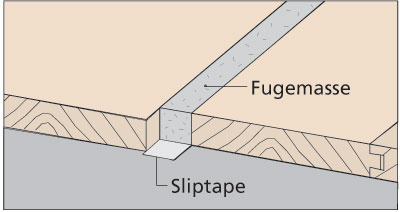 Figur 1. Dilatationsfuge i trægulv
Figur 1. Dilatationsfuge i trægulv
Hvor der er dilatationsfuger i den underliggende konstruktion, skal de altid føres videre i gulvkonstruktionen/ gulvbelægningen. Se figur 2

Figur 2. Dilatationsfuger i bærende konstruktioner skal føres igennem den samlede gulvopbygning. Gulvfladerne er her vist adskilt af vinkelprofiler og en fugemasse. Der findes imidlertid andre velegnede løsninger.
I svømmende gulve kan der være behov for yderligere fuger afhængigt af konstruktionsopbygning, gulvets geometri og belastningen. Derudover er dilatationsfuger normalt kun nødvendige i svømmende gulve og i pladegulve på strøer.
Isolationsfuger
Isolationsfuger benyttes til at adskille gulvet fra tilstødende bygningsdele fx søjler og vægge. Isolationsfuger kan også fungere som dilatationsfuger.
 Figur 3a. Isolationsfuge i trægulv
Figur 3a. Isolationsfuge i trægulv
Skibsfuger (nåddefuger)
Skibsfuger i trægulve laves ved udfræsning af et spor ved siden af feren på bræddernes overside. Sporet udfyldes med fugemateriale således, at fugen mellem brædderne bliver markeret.
Fugematerialet kan være en fugemasse, en træliste eller en gummiliste i kontrastfarve.
Skibsfuger af fugemasse skal udføres som andre fugemassefuger i trægulve dvs. med kvadratisk tværsnit, med bundstop, primning etc.
 Figur 3b. Skibsfuge (nåddefuge) i trægulv
Figur 3b. Skibsfuge (nåddefuge) i trægulv
Gulvet grovslibes inden fugning og finslibes først, når fugemassen er helt gennemhærdet, hvilket vil tage nogle dage afhængigt af fugemassetypen.
Ved skibsfuger af trælister eller gummilister nedlægges listerne i det udfræsede spor, hvor de fastholdes mekanisk gennem en særlig udformning af sporet og/eller ved limning.
For trælister sker limning med vandfast lim.
For gummilister limes der kun i krævende tilfælde, og her bør gulvleverandørens anvisninger følges. Endesamlinger af gummilister kan limes med cyanoacrylatlim ("10- sekunders lim").
Dilatationsfuger med fugeprofiler
Hvor der forventes store bevægelser, eller hvor der ikke må ske vedhæftning mellem materialerne på fugens to sider, anvendes fuger udført med fugeprofiler.

Figur 4. Dilatationsfuge med metalprofil. Elastisk gulvbelægning på afrettet betondæk.

Figur 5. Dilatationsfuge i trægulv. Øverst: Synligt standardprofil til montering oppefra. Bedst egnet som dilatationsfuge på limede/skruede gulve Nederst: Skjult standardprofil, der monteres på undergulvet, før trægulvet lægges.
Fugeprofiler kan fx være aluminiumprofiler.
De findes både til brug med samme belægning eller forskellig belægning på de to sider af fugen, fx træ mod gulve af andre materialer. Desuden findes profiler der kan anvendes, hvor højdeforskelle mellem to sammenstødende gulvflader skal optages.
Fuger med fugemasse
Fuger med fugemasse kan kun udføres, når gulvbelægningen har tilstrækkelig tykkelse til, at fugen kan opnå den nødvendige geometri. I praksis betyder det, at fugemasser kun kan benyttes til fuger i trægulve og gulve af fliser eller klinker.
Til trægulve benyttes elastiske polysulfid-, MS-polymereller polyuretanfugemasser, som af hensyn til trædefasthed og slid bør have en hårdhed på 40 - 65°Shore A.
Til klinke- eller flisegulve anvendes normalt en siliconebaseret fugemasse.
Til fuger langs vægge kan der anvendes en blødere og svagere fuge.
Der anvendes bundstop, fx sliptape, for at undgå vedhæftning i fugebunden. Dilatations- og isolationsfuger skal altid sikres understøtning. Anvend derfor aldrig fuger i flyvestød.
Fugebredder bør være mindst 8 mm og højst 15 mm. Ved vægge, søjler mv. kan fugerne dog være op til 30 mm brede.
For yderligere information om fugemassefuger henvises til Fugebranchens Samarbejds- og Oplysningsråds retningslinier for fuger i gulve.
Forsegling med fugemasse
Ved tilskæring af belægninger på trin med reces eller ved tæt tilskæring til vægge uden fodpanel forsegles med en egnet fugemasse. Det skal af beskrivelsen fremgå, hvem der udfører forseglingen.
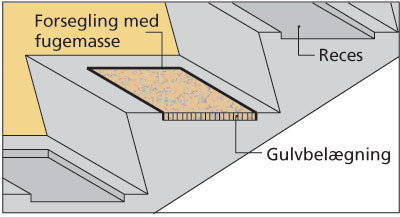
Figur 6. Forsegling med fugemasse. Betontrappetrin med reces Forsegling med fugemasse Reces

